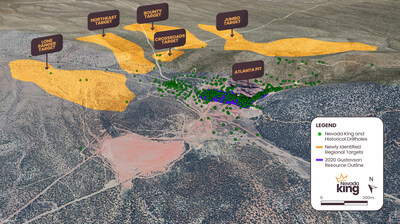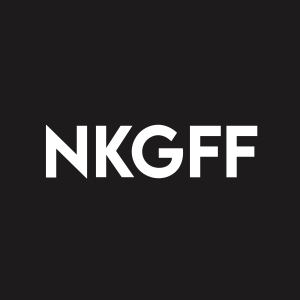NEVADA KING IDENTIFIES FIVE HIGH-PRIORITY DRILL-READY REGIONAL EXPLORATION TARGETS
Rhea-AI Summary
Nevada King Gold Corp. (TSXV: NKG) (OTC: NKGFF) has identified five new high-priority drill-ready regional exploration targets at its Atlanta Gold Mine Project in Nevada. The targets - Lone Ranger, Northeast, Crossroads, Bounty, and Jumbo - cover a combined 13.9km2 area north and northeast of the historical Atlanta Mine.
These targets were identified using geophysical data from CSAMT, drone magnetics, and gravity surveys. They occur where intrusive bodies coincide with major basement faults that potentially channeled gold-bearing fluids. The company plans a Phase III regional drilling program to test these targets, pending BLM approval.
The targets are mostly buried under barren dolomite, post-mineral volcanics, and alluvium. Three have never been drill-tested, while two have a few shallow historical holes. This exploration strategy follows recent discoveries near the Atlanta resource zone based on CSAMT signatures.
Positive
- Identification of five new high-priority exploration targets, expanding potential resource area
- Successful use of geophysical data to identify new targets, demonstrating effective exploration strategy
- Planned Phase III regional drilling program to test the new targets
- Recent discoveries near Atlanta resource zone validate the exploration approach
Negative
- New targets are mostly buried, potentially increasing exploration costs
- Phase III drilling program still pending BLM approval
- Three of the five targets have never been drill-tested, indicating higher exploration risk
News Market Reaction 1 Alert
On the day this news was published, NKGFF gained 7.69%, reflecting a notable positive market reaction.
Data tracked by StockTitan Argus on the day of publication.
Highlights:
Nevada King's extensive library of geophysical data consisting of Phase I and II CSAMT, drone magnetics, and gravity surveys conducted across theAtlanta district reveals significant, caldera-related magmatic activity that caused the intrusion of low resistivity igneous plumes upward into the high resistivity Paleozoic basement rocks, occasionally breaking through and reaching the paleo-surface in places. TheAtlanta resource zone provides one such example of an intrusive plume that broke through the basement cap and CSAMT data reveals other such breakthrough points are scattered across the district.- Today's high priority regional targets occur where intrusive bodies coincide with major basement faults potentially responsible for channeling gold-bearing fluids up toward the paleo-surface (Figure 3-8. These targets are buried, covered by barren massive dolomite, post-mineral volcanics, and alluvium. Three of the targets have never been drill-tested, while the other two have a few shallow (<180m) historical holes. A more detailed description of each of the targets can be found in the Target Description section below.
- Over the past months, the Company has announced three new discoveries located near the
Atlanta resource zone that were made based in large part on CSAMT signatures – the East Ridge Target (July 16, 2024), the South Quartzite Ridge Target with 6.28 g/t Au over 54.9m (July 23, 2024), and the Wild West Zone with 4.67 g/t Au over 42.7m (August 19, 2024). - These back-to-back discoveries demonstrate the effectiveness of CSAMT in making new discoveries at
Atlanta and offer fresh insights into the geophysical signatures associated with these major gold occurrence types, which will guide regional targeting to help predict what type of mineralization might be present in a given target area, what to look for in drill cuttings and sample geochemistry, and how best to vector towards mineralized centers. - The Company is planning a Phase III regional drilling program designed to test the five regional targets outlined in today's release, as well as other similar anomalies located south and west of the
Atlanta resource zone. Further details of the program will be released in the coming weeks. BLM (Bureau of Land Management) approval for this drilling program is currently pending.
Cal Herron, Exploration Manager of
Target Descriptions
Jumbo Target
The Jumbo target is located 1km due east of the
Bounty Target
The northeast-trending, 1.5km long by 500m wide Bounty target is a shallow, low resistivity zone that is largely covered by alluvium and post-mineral volcanics as shown in Figure 6, but carbonate cover is evident in Figures 5, 7, and 8. For most of its length, the target coincides with the axis of an apparent broad antiform. Variably decalcified and silicified dolomite is seen in outcrop at the southern end of the target zone and in a low knob projecting through the alluvial blanket at the northern end. Rock samples on the knob average 0.03 g/t Au and 50ppm As, indicating weakly anomalous mineralization. Only one historical reverse circulation ("RC") drill hole tested the zone's southern margin but was too shallow (90m deep) to get into potential mineralization underneath the massive dolomite cap. Potential mineralization is most likely of the AT24HG-41 Type where mineralizing fluids were trapped beneath the dense dolomite cap around the intrusive apex. At the far eastern side of CSAMT line 21 (Figure 8) a low-angle, east-dipping resistivity low at the surface occurs on top of dolomite basement, which is similar to what we see (albeit with a gentle westward dip) in the main resource zone. There is potential along the eastern side of the Bounty Target for West Atlanta Graben Type mineralization and the Phase 3 CSAMT in-fill program currently underway will better define this peripheral area and possibly further extend the target northward.
Crossroads Target
The Crossroads Target lies along the West Atlanta Fault (Figure 5) and extends northward from the West Atlanta Graben. Unlike the other four new targets discussed today, the Crossroads is the only one possessing significant historical drill data, which did in fact hit anomalous mineralization. Five holes were drilled into the northern end of the target and one hole tested the western margin. Two RC holes at the northern end hit significant gold mineralization: GC96-04 intersected 0.97 g/t Au over 9.1m at a depth of 108.2 metres while AR-60 intersected 6.1m of 0.54 g/t Au starting at a depth of 112.8 metres. Both holes were collared seven metres apart drilling due east at a -45-degree angle. The mineralized bed that was intersected remains consistent between both holes and intersects the gradational CSAMT signature in between strong high and low resistivity signatures.
Northeast Target
The NNE-trending, 1,400m long by 300m wide Northeast Target sits on the western side (hanging wall side) of the West Atlanta Fault, which is the main mineralizing structure within the
Lone Ranger Target
The Lone Ranger Target occurs on the hanging wall (west side) of the
QA/QC Protocols
All RC samples from the Atlanta Project are split at the drill site and placed in cloth and plastic bags utilizing a nominal 2kg sample weight. CRF standards, blanks, and duplicates are inserted into the sample stream on-site on a one-in-twenty sample basis, meaning all three inserts are included in each 20-sample group. Samples are shipped by a local contractor in large sample shipping crates directly to American Assay Lab in
Qualified Person
The scientific and technical information in this news release has been reviewed and approved by Calvin R. Herron, P.Geo., who is a Qualified Person as defined by National Instrument 43-101 ("NI 43-101").
About Nevada King Gold Corp.
The Atlanta Mine is a historical gold-silver producer with a NI 43-101 compliant pit-constrained resource of 460,000 oz Au in the measured and indicated category (11.0M tonnes at 1.3 g/t) plus an inferred resource of 142,000 oz Au (5.3M tonnes at 0.83 g/t). See the NI 43-101 Technical Report on Resources titled "Atlanta Property,
Resource Category | Tonnes (000s) | Au Grade (ppm) | Contained Au | Ag Grade (ppm) | Contained Ag |
Measured | 4,130 | 1.51 | 200,000 | 14.0 | 1,860,000 |
Indicated | 6,910 | 1.17 | 260,000 | 10.6 | 2,360,000 |
Measured + Indicated | 11,000 | 1.30 | 460,000 | 11.9 | 4,220,000 |
Inferred | 5,310 | 0.83 | 142,000 | 7.3 | 1,240,000 |
Table 1. NI 43-101 Mineral Resources at the Atlanta Mine
Please see the Company's website at www.nevadaking.ca.
Neither the TSX Venture Exchange nor its Regulation Services Provider (as that term is defined in the policies of the TSX Venture Exchange) accepts responsibility for the adequacy or accuracy of this release.
Cautionary Statements Regarding Forward Looking Information
This news release contains certain "forward-looking information" and "forward-looking statements" (collectively "forward-looking statements") within the meaning of applicable securities legislation. All statements, other than statements of historical fact, included herein, without limitation, statements relating the future operations and activities of
![]() View original content to download multimedia:https://www.prnewswire.com/news-releases/nevada-king-identifies-five-high-priority-drill-ready-regional-exploration-targets-302250125.html
View original content to download multimedia:https://www.prnewswire.com/news-releases/nevada-king-identifies-five-high-priority-drill-ready-regional-exploration-targets-302250125.html
SOURCE Nevada King Gold Corp.

















